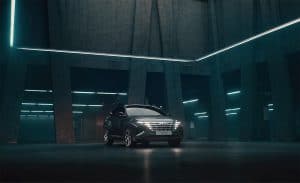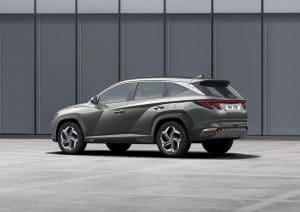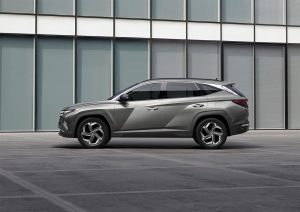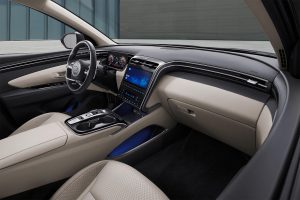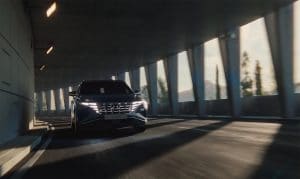Like a classic fan dancer, Hyundai has been teasing the debut of the 2022 Tucson for some months. Now the new SUV finally stands naked before us and reveals the latest take on the Korean carmaker’s
“Sensuous Sportiness” design language.
Hyundai has a lot riding on the launch of the new SUV considering Tucson is its global best-seller. But there’s more to the 2022 model than just a sportier design. The new ute offers a variety of new features, including a 10.35-inch floating touchscreen. But the big news from a powertrain position is that the new model will offer both hybrid and plug-in hybrid options, along with a conventional, 2.5-liter gas engine.
“We are thrilled to introduce the all-new Tucson, the latest model in Hyundai’s SUV transformation,” Thomas Schemera, executive vice president and head of the Product Division at Hyundai Motor Group, said ahead of the fourth-generation SUV’s Monday unveiling. “This exciting vehicle sets a new benchmark for innovation in its segment, delivering an impressive blend of design, technology, packaging and performance.”
(First Look: 2021 Hyundai Tucson.)
The 2022 Tucson clearly echoes the design theme of the Hyundai Vision T concept revealed last November at the Los Angeles Auto Show, while also picking up on other recent product updates, including the latest Sonata and Elantra sedans. That starts with the new “Parametric Hidden Lights” emerging from the jewel-like front grille.
With the emergence of LEDs and other new technologies, distinctive lighting has become a favorite tool of automotive designers.
The new Sonata, for example, has lights that emerge, unexpectedly, from under what appear to be chrome strips on the front of the sedan. With Tucson, Hyundai has taken a similarly bold approach, with the delta-shaped pattern of its daytime running lights largely hidden until switched on, only the headlights visible at all times.
At the rear, a Light bar runs across the tailgate and flows into the rear fenders. It is accented by a quartet of diagonal light blades.
We’ve seen plenty of recent SUVs adopt “floating rooflines,” meanwhile, with their rear pillars
blacked out. The new Tucson flips that theme, a bright accent strip rising to frame the windshield and then flowing with the roofline before plunging to meet the tailgate.
As dramatic as the exterior design might seem, the interior is equally fresh, partitioned into the more cockpit-like layout you’d expect from a sports car, rather than a sport-utility vehicle.
The big new infotainment screen – as well as a smaller, 8-inch display on low-trim models – appears to float in front of the center stack and is paired with hard buttons to handle frequently accessed functions without forcing drivers to dive down several screens to operate things like cabin temperature and radio volume.
Along with the new touchscreen, the cabin adopts a multi-air ventilation system and an open, hoodless digital gauge cluster, Hyundai notes.
(Hyundai punches things up with launch of Elantra N-Line.)
As with the Sonata and Elantra, Hyundai is clearly aiming to provide a “class above” appearance which, said SangYup Lee, senior vice president and head of Hyundai Global Design Center, is meant to “raise the game in the industry’s most competitive segment.”
But, from a technical standpoint, it’s the new trio of powertrain options that will likely catch the attention of potential buyers. They include:
- A 2.5-liter direct-injection inline-four gas engine making 187 horsepower and 182 pound-feet of torque;
- A 1.6-liter hybrid powertrain that pumps out about 177 hp from the gas engine and 227 combined. Torque is a combined 258 lb-ft. The package further improves fuel efficiency with Hyundai’s Continuously Variable Valve Duration system;
- A plug-in hybrid using the same 1.6-liter gas engine and electric motor combination. The package has the same output as the conventional hybrid and is expected to yield substantially more electric-only range, though Hyundai has yet to reveal specific details.
As with other new Hyundai products, the 2022 Tucson gets the automaker’s Hyundai SmartSense suite of advanced driver assistance systems, including forward collision avoidance with pedestrian detection, lane keeping and following assist, blind-spot monitoring and more.
The South Korean automaker also noted that a number of additional ADAS systems, such as Active Cruise Control and rear cross-traffic avoidance, are available as options.
The new crossover will be produced in two different lengths, the U.S. getting the long-wheelbase version only.
Meanwhile, a sportier Tucson N Line model will be added at a later date, according to Hyundai. It’s expected to make as much as 340 horsepower.
(Hyundai and Aptiv name AV venture: Motional.)
The new Hyundai Tucson will go on sale later this year in the Korean market as a 2021 model. “It will go on sale in the U.S. and other global markets as a 2022 model starting from the first half of 2021,” according to the automaker.

